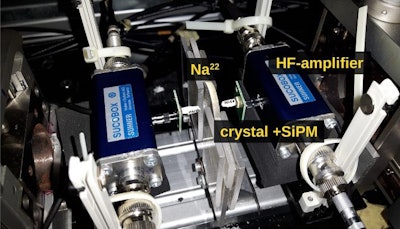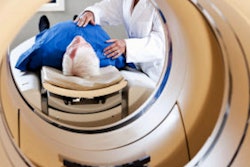
Researchers at CERN, the European Organization for Nuclear Research in Geneva, Switzerland, have placed new limits on the timing performance of state-of-the-art systems for time-of-flight PET (TOF-PET).
Their tests show that the best photodetectors and scintillation materials can achieve a timing resolution far below 100 ps -- a fivefold improvement on standard commercial systems. If implemented in the clinic, these advances would enhance the quality of PET images, enabling doctors to reduce the dose of radioactive tracer they administer to patients.
TOF-PET is a highly sensitive imaging technique that reconstructs a 3D view of tissues using precise measurements of the times at which two simultaneously emitted gamma-ray photons arrive at a scintillator-based detector. These photons are produced when the decay of a radioactive tracer triggers electron-positron annihilations inside the patient's body.
Most commercial TOF-PET systems, which exploit silicon photomultiplier photodetectors (SiPMs) and the fast scintillator lutetium oxyorthosilicate (LSO:Ce), achieve a timing resolution of around 500 ps for whole-body scans. For more localized imaging, 200 ps seems within reach. But a group of more than 40 scientists -- including several authors involved in this work -- have launched a competition called the 10 ps Challenge that aims to push the limits even further. Imaging on this timescale could deliver a 16-fold improvement in sensitivity and avoid the need for computational techniques to reconstruct the image.
 Scientists are pushing the performance of TOF-PET systems. Image courtesy of Gundacker et al, Physics in Medicine and Biology, January 2020, Vol. 65:2.
Scientists are pushing the performance of TOF-PET systems. Image courtesy of Gundacker et al, Physics in Medicine and Biology, January 2020, Vol. 65:2.Comparing photodetectors
In this study, reported in Physics in Medicine and Biology (January 2020, Vol. 65:2), Stefan Gundacker, PhD, and colleagues have made the most precise measurements yet of the timing performance of leading scintillation materials and photodetectors. They first measured the intrinsic single-photon timing resolution (SPTR) of eight industrial and research SiPMs, with the best value of 70 ps achieved by the NUV-HD device from Italian research institute Fondazione Bruno Kessler (FBK). By combining this detector with a small crystal of LSO:Ce co-doped with calcium, they demonstrated an overall timing resolution of 58 ps, increasing to 98 ps for the 20-mm-long crystals typically used in TOF-PET.
The team then used the FBK device to measure the timing response of different scintillating materials, including bismuth germanate (BGO), which is cheaper than LSO:Ce and slightly safer for clinical environments. High-frequency readout electronics were able to capture extremely fast scintillation processes, revealing a pronounced peak in the light emitted from BGO within just a few picoseconds. This is caused by Cherenkov emission, and the team estimates that BGO emits 17 prompt Cherenkov photons from each gamma-ray interaction.
The measurements also show a direct correlation between the timing performance of the TOF-PET system and the intrinsic SPTR of the photodetector, with simulations indicating that this fast Cherenkov emission could improve the timing resolution of BGO-based systems if the SPTR of the photodetector can be reduced. For example, an idealized detector with an SPTR of 20 ps -- which has been measured on research devices -- would enable BGO systems to reach a timing resolution of around 30 ps for small crystals, compared with 158 ps measured for the FBK photodetector used in this study.
"We are still far from having a perfect photodetector in PET," Gundacker told Physics World. "But there are other intermediate solutions to investigate, especially in the case of BGO where we have shown that detecting the first photon with high time precision would already be sufficient."
Pushing boundaries
The tests also reveal that BC422 plastic scintillators are even faster than LSO:Ce, although their low detection efficiency rules them out for PET applications. The most promising alternative is the ultraviolet emitter barium fluoride (BaF2), which achieved a timing resolution of 51 ps when combined with a UV photodetector from FBK -- with further improvements possible by pushing the performance of the UV detector.
The team concludes, however, that current devices and materials will not be good enough for practical, commercial TOF-PET systems to break the 100 ps barrier, let alone the more ambitious 10 ps challenge. To make further progress toward this target, researchers will need to investigate novel approaches such as quantum-confined systems, as well as better methods for collecting and detecting the light.
Susan Curtis is a freelance science writer based in the U.K.
© IOP Publishing Limited. Republished with permission from Physics World, a website that helps scientists working in academic and industrial research stay up to date with the latest breakthroughs in physics and interdisciplinary science.



















